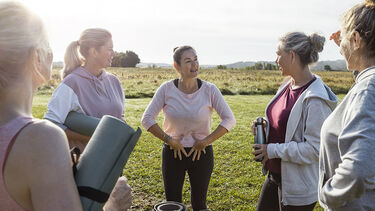
While we might think about toning our abs or building the muscles in our arms and legs, it’s easy to forget that our pelvic floor muscles need attention, too.
We talk to Jean Hailes physiotherapist Amy Steventon about the pelvic floor muscles, including what they are and why they so often get overlooked.
Ms Steventon: The pelvic floor is made up of the pelvic floor muscles, or PFMs, and supportive structures. The PFMs are internal muscles that provide support to the bladder, uterus and bowel.
They help maintain bladder (urine) and bowel (wind and faeces) control, and also contribute to sexual enjoyment.
Ms Steventon: They cannot be seen from the outside, so are easy to forget.
Also, many issues with the pelvic floor are considered taboo and not openly discussed. These include urinary or faecal incontinence, pelvic pain, sexual difficulties and pelvic organ prolapse(s), where one or more of the pelvic organs descends from its correct anatomical position.
Ms Steventon: Absolutely! If incontinence is an issue, pelvic floor exercises can cure or significantly improve the type of leakage that happens with coughing, sneezing and exercising by up to 80%.
Regular, targeted pelvic floor exercises can also help you maintain or increase bowel and wind control, improve sexual function (greater sensation and arousal), and prevent pelvic organ prolapse or reduce prolapse symptoms.
But you have to do the exercises correctly. One in three women don’t, so if you have tried pelvic floor exercises and haven’t seen an improvement, get your exercise technique checked by a pelvic health physio.
Pelvic floor muscle training does not always involve strengthening, although this may be an important consideration. Relaxation – particularly when treating painful sex or persistent pelvic pain – is an important component of pelvic floor muscle function as well.
Ms Steventon: Pregnancy and childbirth are often the first time a woman will learn about her PFMs. That’s because they stretch and weaken during pregnancy and delivery, making pelvic floor exercises important at this time.
It’s not uncommon for new and expecting mums to experience urinary and faecal incontinence, but that doesn’t make it ‘normal’.
Issues can also crop up around menopause, thanks to hormonal changes, and also after gynaecological surgery.
Ms Steventon: If women are wanting to improve the strength and function of their pelvic floor muscles, it’s important to exercise them three to four times each day.
Once their strength has improved or their symptoms have resolved, drop back to once each day, or with daily activities such as when coughing, sneezing, laughing or lifting.
Ms Steventon: Pelvic floor muscle training does not always involve strengthening, although this may be an important consideration. Relaxation – particularly when treating painful sex or persistent pelvic pain – is an important component of pelvic floor muscle function as well.

Stock photos used. Posed by models.
All reasonable steps have been taken to ensure the information created by Jean Hailes Foundation, and published on this website is accurate as at the time of its creation.
© 2026 Jean Hailes Foundation. All rights reserved. This publication may not be reproduced in whole or in part by any means without written permission of the copyright owner. Contact: licensing@jeanhailes.org.au